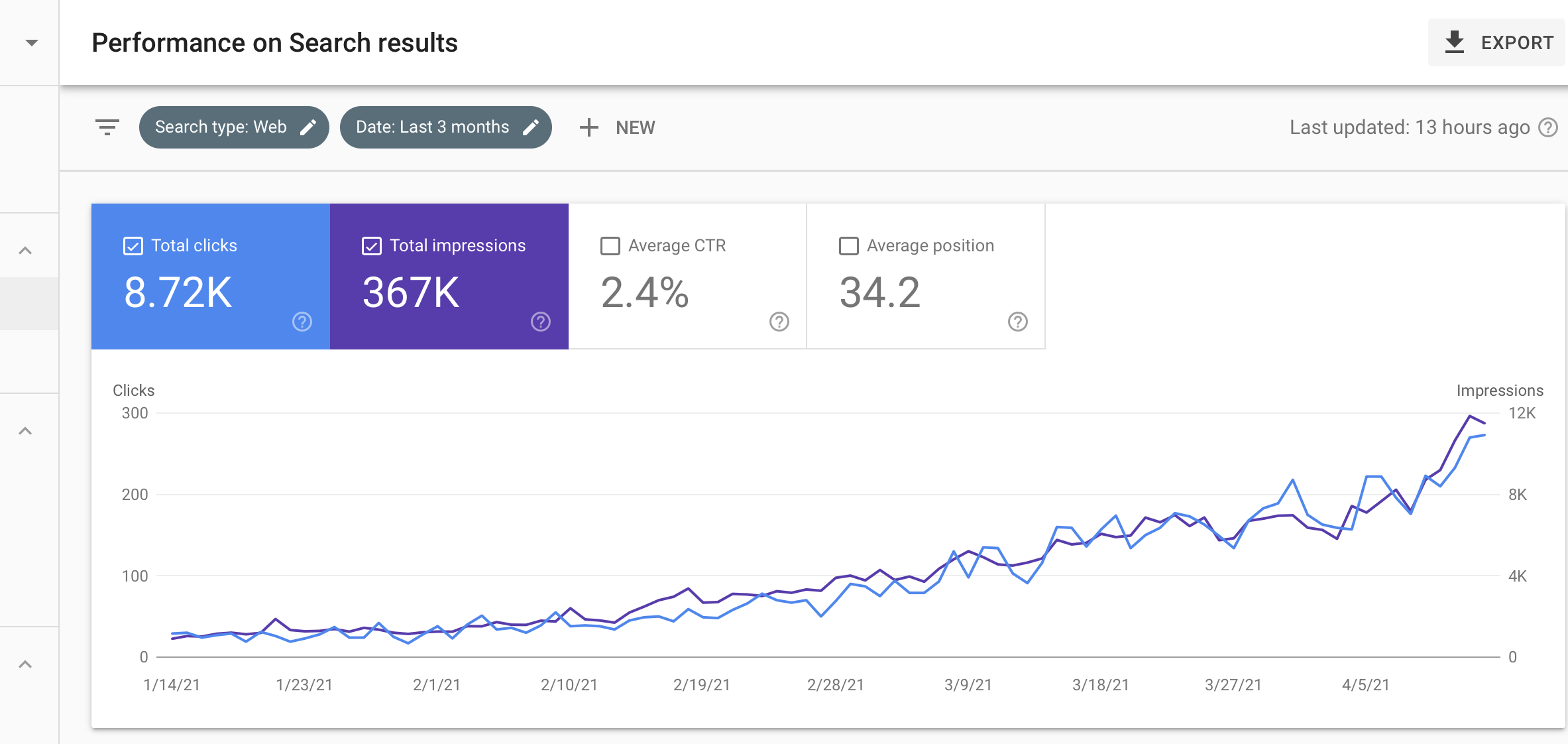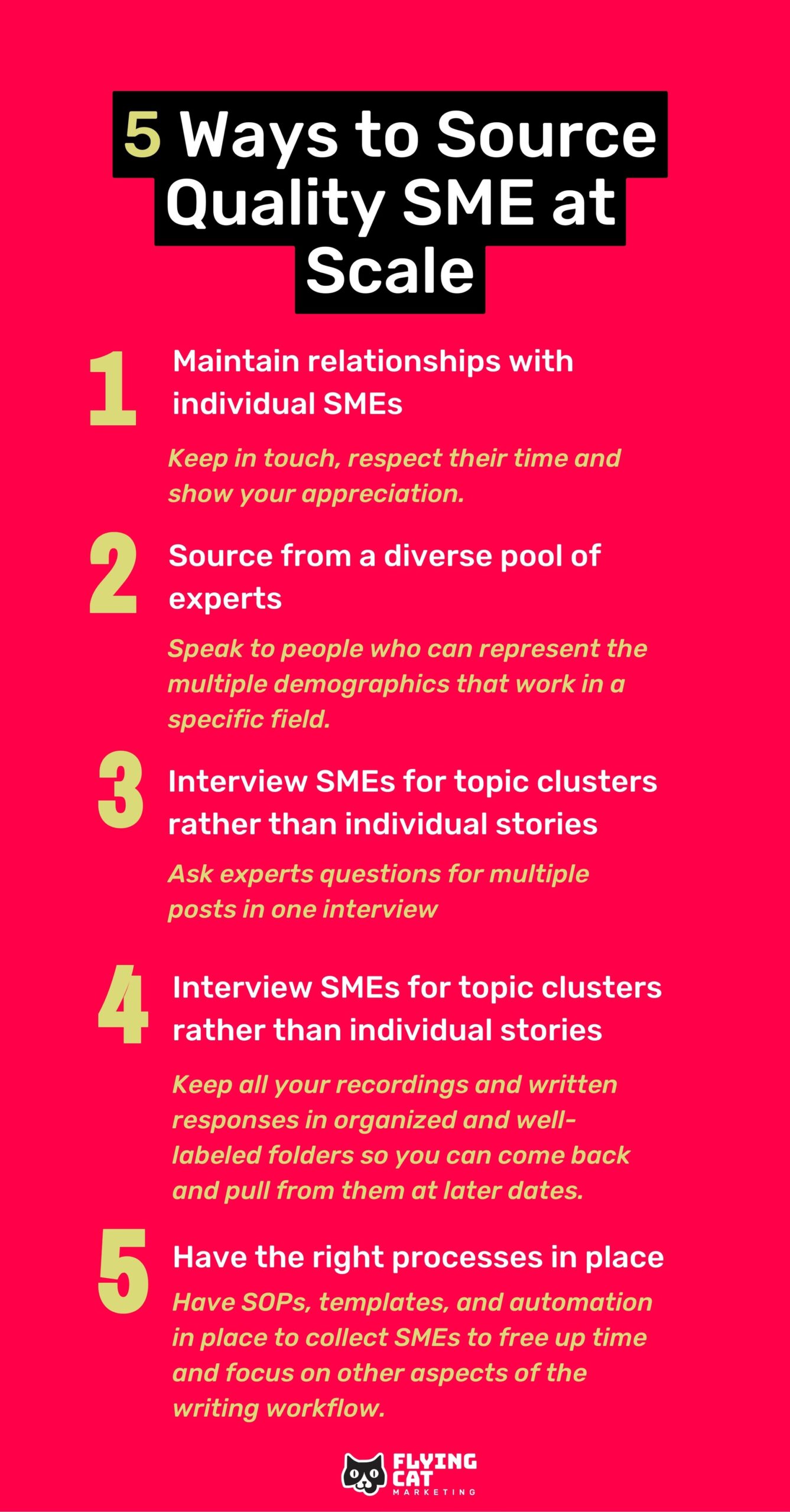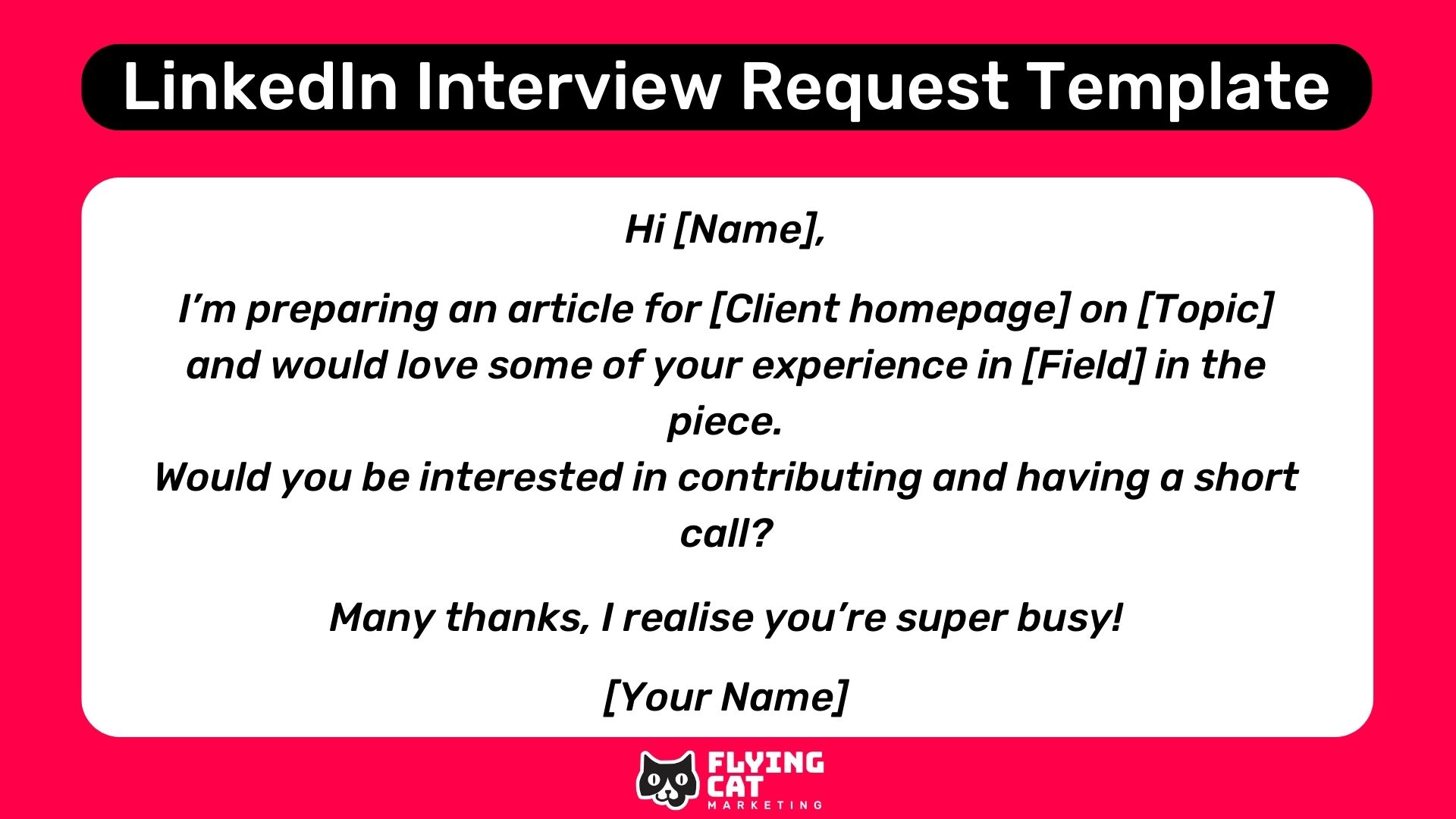5 Ways to Source Quality SME at Scale
With new Google updates and AI rollouts, competing for a spot at the top of the search results page has become more complicated. You need to contend with tools like ChatGPT, Writesonic, and more, which are adding a lot of generic content to an already weak space.
Rather than making it more challenging, the rise of AI writing has made it easier for those with truly insightful and useful information to rank, as Google updates continue to weed out regurgitated AI content. At Flying Cat Marketing, we believe that while AI has its place, the best way to add value to your content is through subject matter expertise (SME), which is gathered by interviewing relevant subject matter experts (SMEs), such as business owners, department heads, directors, and more.
The biggest challenge with the Generative AI Google update will be to collect better SME than your competitors that explores a different angle of your topic. In addition to quality, your content needs to have an element of uniqueness to be picked up by the SERPs.
However, sourcing high-quality SME in an efficient and scalable way can be tricky and time-consuming. You’re probably too busy wearing many hats in your day-to-day, dealing with freelancer deadlines, and working on a tight budget to deal with chasing down SMEs. Implementing a solid SME interviewing and scaling process can help you get through your to-do list much faster.
Not sure where to begin with finding SMEs and scaling the information you get from interviews?
We got you covered:
- Why SME matters now more than ever in an EEAT & AI era
- Challenges with sourcing SME for your content
- Where to look for relevant SME
- 5 ways of scaling SME sourcing
- Establishing SME best practices within your team
Still struggling to scale content production with great SME?
Flying Cat Marketing can help you source SME with repeatable and scalable processes.

Why SME matters now more than ever in an EEAT & AI era
In a world where AI is authoring an increasing amount of content, human writers will need to be even more competitive and innovative when it comes to SEO. The Generative AI rollout will mean that instead of simply aiming for page 1 of the SERPs, you now need to either be featured in the AI Snapshots or rank in the first 3 positions to get any traffic to your page.
As AI continues to become more powerful, we’ll start seeing more and more generic, machine-generated content that is a regurgitation of the first page of the SERP. This means that to produce content that resonates with your audience, adds value, and stands out from the rest, you need high-quality SME now more than ever.
“When testing [Google Search Generative Experience], I learned that the sites shown in the AI Snapshot carousel are not the same links as shown in the classic search results”, says Kevin Indig, creator of the Growth Memo newsletter and host of the Tech Bound podcast. “You would think Google forms AI answers out of the top Search results, but that’s not the case. If AI Snapshot carousels get most organic clicks, but Google doesn’t pick the best-ranking sites, we need to re-evaluate what signals Google uses to put the carousel together.”
Uniqueness in angle is a ranking factor for being featured in the AI Snapshot, and as they become more important, great SME that explores new and innovative angles that haven’t been addressed by the rest of the SERP will be key to boosting your ranks and EEAT (experience, expertise, authoritativeness, and trustworthiness).
Challenges with sourcing SME for your content
While sourcing SME is key to great content that will help you stand out and build your brand, it can be difficult to find and retain. A few common challenges with obtaining great SME include:
1. Determining where to look for relevant SME:
You need a sustainable bank of relevant experts and information that you can lean on. That means going through the process of searching for and identifying individuals that are willing to share their insights with you, which can be tricky if you aren’t sure what websites or platforms to use when contacting SMEs.
We’ll identify some great sources that can assist you with finding SMEs in the next section.
2. Finding time to source SME:
Finding and interviewing SMEs can be very time-consuming for your team. Even if you have a reliable website to use for locating sources, looking for new SMEs from scratch over and over is frustrating. Keeping an updated directory can help you speed up this aspect.
Additionally, you need to take the time to write insightful interview questions that will add value to your content. Writing more generic questions won’t help you stand out from the crowd. Many experts are busy and will take a few days to respond to your questions, which can delay the writing process. However, with the right systems and documents in place to repurpose valuable SME, you can cut down on the time invested for your team.
3. There’s no 1-size-fits-all when it comes to information sources:
To scale your SME and streamline writing processes, you need different alternatives and multiple channels that you can easily tap into. Relying on only one way to collect SME will likely lead to roadblocks if that method becomes unavailable or takes a long time to process. Relying on only one source or way to collect SME may compromise the quality of your content or prevent you from driving relevant traffic.
Expert Tip:Look out for AI Answers
Finding answers to interview questions that are 100% human-written is becoming more difficult. If you aren’t sure how to separate the AI answers from the human answers, here are a couple of tips:
1. In your questions, include phrases like: “In your experience”2. Use words like “feeling” or “thinking,” that an AI language model couldn’t answer3. Ask for specific stories, anecdotes, or experiences. Stay away from general requests you can answer through a simple Google search
Where to look for relevant SME
Search for experts through reliable sources. A few of our favorite places to source SMEs at Flying Cat include:
- Qwoted: This website helps to connect you with relevant sources that can enhance your content. Even though the site does a pretty good job of keeping out AI-written responses, you can prevent these from coming through by requesting recorded interviews rather than written responses.
- LinkedIn: Searching for users with relevant job titles and reaching out to them for interview requests can be a great option. If you’re able to continuously build out your network with great SMEs as you go, that’s a great way to scale your sourcing as well.
- Online communities and forums: Online communities or groups, such as industry-specific Slack channels, are good options for finding experts that are interested in sharing their insight. However, since many platforms require monthly fees or dues, these can be harder to access.
- Client recommendations: If your client or team knows someone who can provide insight into your topics, reaching out to them directly is a solid way to get expertise. That way, you know they aren’t a random bot that responded to a written request, but a verified source of knowledge.
5 ways of scaling SME sourcing
Scaling SME sourcing is a challenge, but here are 5 best practices we use at Flying Cat Marketing to make it more manageable:


1. Maintain relationships with individual SMEs
When you identify a great SME that provides insightful and unique context to your content, make sure that you respect their time and show your appreciation. This includes responding to their messages promptly (ideally within 24 hours), sharing interview questions in advance so they have time to prepare, ensuring they’re well-represented and linked in the published work, letting them know when a piece they’re quoted in goes live, and more.
Staying connected with SMEs on LinkedIn and interacting with the content they post is a great way to keep your team engaged with them and build a long-lasting relationship. Avoid asking sources for last-minute requests whenever possible, and be respectful of their schedules.
Keeping these names in a shared document organized by industry or topic can help your team get intros to the right SME, and you can all leverage each other’s networks and contacts.
2. Source from a diverse pool of experts
When you’re trying to find SMEs to add context to an industry topic, make sure that you’re speaking to individuals who can represent the multiple demographics that work in a specific field. For example, if you’re writing content about an industry that employs mostly white males, try to seek out an SME that can bring in new information or highlight other voices that don’t fit the majority demographic.
If you use a website like Qwoted, you’ll get multiple responses to the same interview questions, which can help you both scale your information sourcing and pull from a larger pool of experts.
This might mean taking extra time to find these individuals, so budget your capacity to account for the time you’ll need to research SMEs and retain them once they’ve been identified. Then, you can use their unique industry perspectives to scale your SME and remain relevant. At the end of the day, including diverse voices in your content will make it more useful and engaging to your audience.
3. Interview SMEs for topic clusters rather than individual stories
If you know your next few blog or content topics and they’ll have some overlapping themes, consider asking your experts interview questions for multiple posts in one interview. You can also add some additional questions that you could see becoming relevant for later content, even if it hasn’t been completely planned out yet.
This will save both your team and your SMEs valuable time, and it’s an excellent way to get a ton of great information in a short period.
4. Keep an information bank
A key part to scaling your SME is keeping an information bank with quotes and other insight gathered from your interviews with experts. Keep all your recordings and written responses in organized and well-labeled folders so you can come back and pull from them at later dates. That way, you won’t have to reach back out to the same SMEs more than necessary or, even more time-consuming, source completely new ones.
Flying Cat Marketing has some great toolkits, such as a customer desire map with a section for SME quotes and sources, that can help you get started with SME scaling.
5. Have the right processes in place
Your team needs to have the right processes in place for each way of collecting SME. That way, you can gather them in a faster and more standardized format. If you have a workflow and an SOP for every one of these methods, then scaling them is much easier because you don’t have to think about exactly what steps to take. You’ll already have instructions, templates, and even automation in place to collect it, which frees up time to focus on other aspects of the writing workflow.
Establishing SME best practices within your team
Sourcing SMEs is a crucial differentiator for your content. It adds meaningful insight, authority, and engagement, making it well worth the time required. You and your team can cut down on the amount of time used for finding new SME by implementing processes and best practices for scaling and repurposing information.
If your team doesn’t currently have any processes in place for organizing information gathered from SMEs, take initiative and propose some or all of the ideas outlined in this guide. Map out how you can most efficiently contact relevant experts and write interview questions that will set you up for insightful, unique content. With great SME and information repurposing processes in place, you’ll be well on your way to crushing SERPs and driving conversions.
Still struggling to scale content production with great SME?
Flying Cat Marketing can help you source SME with repeatable and scalable processes.



Frequently asked questions about SME
Where is the best place to source SME?
Some of the best places to source SME include LinkedIn, client or colleague recommendations, and websites like Qwoted.
Where should I avoid looking for SME?
Some SME websites don’t offer much protection against bots of AI-generated answers, so be careful which ones you use to request responses to your interview questions. A few sites to avoid include HARO and Help a B2B Writer.
How do I approach SMEs for collaboration?
When reaching out to someone new, create an introductory message that encourages a meaningful relationship with the SME. Generally speaking, small business owners or mid-scale industry influencers are more likely to respond to your message. Since high-profile experts often have many writers and editors reaching out to them, your message needs to be unique to get their attention. It should be clear, intentional, and direct.
For example, here’s a template for connecting with someone new on LinkedIn with an interview request:


How do I compensate SMEs?
Typically, SMEs are compensated by having backlinks to their website or social media profiles included in their quote source. Others may require payment for their time, depending on the extent of the time and effort required for the interview. Payment should always be agreed upon before the interview takes place, and remember to let the expert know when their quotes have been published.
